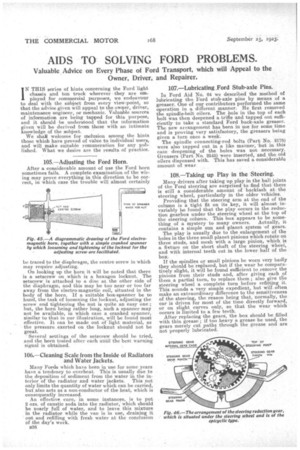AIDS TO SOLVING FORD PROBLEMS.
Page 22

If you've noticed an error in this article please click here to report it so we can fix it.
Valuable Advice on Every Phase of Ford Transport, which will Appeal to the•Owner, Driver, and Repairer.
IN THIS series of hints concerning the Ford 'light chassis and ton truck wherever they are employed for commercial purposes, we endeavour to deal with the subject from every view-point, so that the advice given will appeal to the owner, driver, maintenance engineer, or mechanic. Valuable sources of information are being tapped for this purpose, and it should be understood that the information given will be derived from those with an intimate knowledge of the subject.
We shall welcome for inclusion among the hints those which have proved of value to individual users, and will make suitable remuneration for any published. What we desire are the results of practice.
105.----Adjusting the Ford Horn.
After a considerable amount of use the Ford horn sometimes fails. A complete examination of the wiring may prove everything in this direction to be correct, in which case the trouble will almost certainly
be traced to the diaphragm, the centre screw in which may require adjusting.
On looking up the horn it will be noted that there is a setscrew on which is a hexagon locknut The setscrew is attached to a disc at the other side of the diaphragm, and this may be too near or too far away from the electro-magnetic coil, situated in the body of the horn. If a suitable box-spanner be to hand, the task of loosening the locknut, adjusting the screw and tightening the nut is quite an easy one ; but, the horn being rather long, such a spanner may not be available, in which case a cranked spanner, similar to that in our illustration, will be found most effective. It can be made out of light material, as the pressure exerted on the locknut should not be great.
Several settings of the setscrew s:hould be tried, and the horn tested after each until the best warning signal is obtained.
I06.—Cleaning Scale from the Inside of Radiators and Water Jackets.
Many Fords which have been in use for some years have a tendency to overheat This is usually due to the deposition of sediment from the water in the interior of the radiator and water jackets. This not only limits the quantity of water which can be carried, but also acts as a non-conductor of the heat, which is consequently increased.
An effective cure, in some instances, is to put 2 ozs. of caustic soda into the radiator, which should be nearly full of water, and to leave this mixture in the radiator while the van is in use' draining. it out. and refilling with fresh water at the conclusion of the day's work.
n38
107.—Lubricating, ford Stub-axle Pins.
In Ford Aid No. 64 we described the method of lubricating the Ford stub-axle pins by means of a greaser. One of our contributors performed the same
eration in a different manner. He first removed the spindle-bolt oilers. The hole in the top of each bolt was then deepened a trifle and tapped out sufficiently to take a standard Ford back-axle greaser. The new arrangement has been in use for some time and is proving very satisfactory, the greasers being given a turn once a week.
The spindle connecting-rod bolts (Part No. 2178) were also tapped out in a like manner' but in this ease deepening of the holes was not .necessary. Greasers (Part No. 2545) were inserted, and the old oilers dispensed with. This has saved a considerable amount of wear
108.—Taking up Play in the Steering.
Many drivers after taking up play in the ball joints of the Ford steering are surprised to find that there is still a considerable amount of backlash at the steering wheel, particularly in the older vehicles. Providing that the steering arm at the end of the column is a tight fit on its key, it will almost in: variably be found that the play occurs in the reduction gearbox under the steering wheel at the top of the steering column. This box appears to be something of a mystery to many owners. Actually, it contains a simple sun and planet system of gears. The play is usually due to the enlargement of the holes in the three small planet pinions Which rotate on three studs, and mesh with a large pinion, which is a fixture on the short shaft of the steering wheel, and with internal teeth cut in the lower half of the box.
If the spindles or small pinions be worn very badly they should be replaced, but if the wear be comparatively slight, it will be found sufficient to remove the pinions from their studs and, after giving each of them a partial turn, to replace them ; also give tife steering wheel a complete turn before refitting it. This sounds a very simple expedient, but will often make an extraordinary difference to the sensitiveness of the steering, the reason being that, normally, the car is driven for most of the time directly forward, or on slight curves only, so that the wear which occurs is limited to a few teeth. After replacing the gears, the box should be filled with thin grease ; if too heavy a grease be used, the gears merely cut paths through the grease and are not properly lubricated.






























